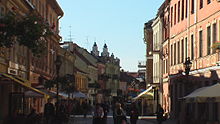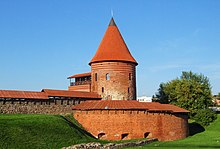Kaunas
![]()
The title of this article is ambiguous. For other meanings, see Kaunas (disambiguation).
Kaunas![]() is the second largest city in Lithuania with a population of over 315,000 (as of 2021) and is the centre of the Kaunas administrative district. It has the status of a city municipality, thus has an elected mayor and city council. It is surrounded by the Kaunas rayon municipality, of which it is the administrative seat.
is the second largest city in Lithuania with a population of over 315,000 (as of 2021) and is the centre of the Kaunas administrative district. It has the status of a city municipality, thus has an elected mayor and city council. It is surrounded by the Kaunas rayon municipality, of which it is the administrative seat.
In addition to a diversified economy favoured by the city's transport location, Kaunas has several universities and many galleries. Textile art in particular, with its roots in the traditionally strong textile industry, is strongly represented in the city, which is also reflected in the large, now internationally highly respected Kaunas Textile Art Biennial. The city will be European Capital of Culture in 2022, together with Esch an der Alzette in Luxembourg.
Geography
Location
Kaunas is located at the confluence of the Memel (Lithuanian Nemunas) and Neris rivers about 100 km west of the Lithuanian capital Vilnius, near the geographical centre of the country in the Central Lithuanian Lowlands. Above the town, the Memel has been dammed since 1959 to form the Kaunas Sea, and to the west of the town is the Lampėdis, an approximately 125 ha lake north of the Memel, which was formed from a flooded gravel pit and is used as a recreational area.
Climate
Kaunas with its humid climate is located in the cool temperate climate zone with influence of continental climate. In the climate classification it is classified as DfB, that is:
- (D) the coldest month has a temperature of less than -3 °C, the warmest month is above 10 °C,
- (f) all months are wet and
- (B) the temperature is below 22 °C, but there are still at least four months that are warmer than 10 °C.
The average annual temperature in the city is about 6 °C. Although the annual precipitation is only 609 mm (for comparison Cologne: 798 mm), it is higher than the evaporation, which is why a humid climate prevails.
The warmest months are July and August with an average of 18.2 °C and 17.5 °C respectively, the coldest months are January and February with an average of -3.3 °C and -3.1 °C respectively. The most precipitation falls in June and July with an average of 74 mm and 71 mm respectively, the least in February with an average of 27 mm.
| Kaunas | ||||||||||||||||||||||||||||||||||||||||||||||||
| Climate diagram | ||||||||||||||||||||||||||||||||||||||||||||||||
| ||||||||||||||||||||||||||||||||||||||||||||||||
| Monthly average temperatures and precipitation for Kaunas
Source: wetterkontor.de | |||||||||||||||||||||||||||||||||||||||||||||||||||||||||||||||||||||||||||||||||||||||||||||||||||||||||||||||||||||||||||||||||||||||||||||||||||||||||||||||||||||||||||||||||||||||||||||||||||||||||||||||||||||||||||||||||||||||||||||||||||||||||||||||||||||||||||

"Vilniaus gatvė" in the Old Town
History
Medieval
A Lithuanian castle at the mouth of the Neris into the Memel was first mentioned in 1361. This castle was repeatedly conquered or destroyed by knights of the Teutonic Order, but always immediately rebuilt by the Lithuanians. The main reason for the Lithuanian wars of the Teutonic Order and its attacks on Kaunas was the attempt of the Order to connect its territories in East Prussia and in Livonia in order to establish a unified and compact dominion from Estonia via Livonia to East Prussia. On this north-south axis, the castle in Kaunas represented an important obstacle to the ambitions of the Teutonic Order. With the crushing defeat of the Teutonic Order in the Battle of Tannenberg against the united Lithuanians and Poles in July 1410, this conflict was decided in favour of the Lithuanians.
The town then lost its importance as a fortress, but experienced an upswing as a trading town. After the settlement had already received the Magdeburg city rights in 1408, a Hanseatic trading post was opened in 1440. Trade was joined by crafts and the formerly strategically important and hard-fought castle settlement became a conveniently located, rich and large city in the Polish-Lithuanian state.
Modern Times
The 17th and 18th centuries brought hard times for Kaunas: from 1655 to 1661 the city was occupied by Russian troops, in 1701 by the Swedes. In 1670 and 1732 fires destroyed the city, the plague raged repeatedly.
Since the 16th century Kaunas, like many places in present-day Lithuania, developed into an important Jewish center and thus played a role in the history of the Jews in Lithuania. After a pogrom in 1761, the Jews moved from the ghetto imposed on them in the city centre to the suburb of Slobodka, and Slobodka thereafter stood as a term for a "Talmudic teaching centre of European rank".
In 1900, the proportion of Jews in the population of Kaunas was about 37%. The Choral Synagogue is preserved from that time.
After Kaunas fell to Russia in the course of the Third Partition of Poland in 1795, the city became the Russian governorate capital of the Kovno governorate in 1831. In 1879 the Russians began to develop the city into a fortress, a ring of seven forts and nine batteries along with further fortifications was drawn around the city, to which an eighth fort was added in 1889.
In 1912 a major expansion of the fortress began, but due to the First World War only Fort IX was completed before the German army conquered the city in 1915. In 1918, Lithuania declared itself independent while still under German occupation, and in December a city council was elected for the first time, with all men and women over the age of 20 eligible to vote. In 1920, Polish troops intervened in Lithuania during the Polish-Lithuanian War, occupying the traditional Lithuanian capital Vilnius, which had a predominantly Polish-speaking population, and incorporating the entire Vilnius region into Polish territory, justified by the population composition there. Kaunas was therefore the provisional capital of Lithuania (Laikinoji Sostine) from 1920 to 1940.
Following the ideas of the Settlement movement, the physician and educator Siegfried Lehmann founded a Jewish Children's Home in Kaunas in 1921, where mainly war orphans were cared for. At the end of 1926, Lehmann and his wife, the physician Rivkah Rebecca Klivanski († 1959), left for Palestine with a group of young people who had been educated here according to Reform pedagogical and Zionist ideals and who had also received manual training. There, in 1927, they founded the Ben Shemen Children's and Youth Village, which still exists today.
In 1940 the Red Army occupied the city. This was followed by deportations, mainly of the Lithuanian educated and propertied bourgeoisie, to the interior of the USSR. In June 1941, the German Wehrmacht marched in and remained as the occupying force in the town, which the Germans called Kauen, until the summer of 1944. Immediately after the invasion of the Wehrmacht, there were mass murders of Jews in the open streets by Lithuanian nationalists and sponsored or tolerated by the German authorities (Kaunas Pogrom). Soon the Jewish population was herded into the newly created ghetto Slobodka (= concentration camp Kauen) on the other side of the Neris (today: Vilijampole district) and successively murdered in three nearby forts (memorial in Fort IX) or deported to other concentration camps. Later, POW camp 296 for German prisoners of war of World War II existed in the town. Those who were seriously ill were cared for in prisoner-of-war hospital 1245. In 1944 Lithuanians also fled from Kaunas before the return of the Red Army to Germany. From 1940 - interrupted by the German occupation - until Lithuania regained its independence, Kaunas belonged to the Lithuanian Soviet Republic, whose capital once again became Vilnius.
In the course of the reform of the administrative division of Lithuania, the current municipality was created in 1995. The eleven Seniūnijos (municipal districts) were established in 2000. Today the city is primarily an industrial, educational and scientific centre. Due to its location, it is the most important transport hub in Lithuania.

Young students of the Nieviazer Cheder in the courtyard of a synagogue, 1934.
,_Blick_in_die_Altstadt.jpg)
Old town in the 1930s

Kaunas Castle Ruin
Search within the encyclopedia